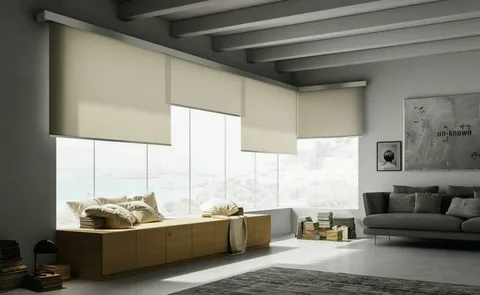Table of Contents
- Introduction
- What Is Blindspace?
- Why Blindspace Suits Luxury Interiors
- Design Benefits: Minimalism Meets Detail
- How Blindspace Works with Different Blind Types
- Room-by-Room Applications in London Homes
- Installation, Measurement & Local Considerations
- Smart Integration & Blind Systems Harmony
- Cost, Suppliers and Contract Considerations
- Styling Tips & Final Checklist
- Conclusion
- FAQs
Introduction
London interiors have a special language — polished, layered, and quietly confident. In that language, every detail matters: joinery, cornice lines, the exact hue of a skirting board. One modern detail that designers and homeowners are using to great effect is Blindspace — the approach that hides blinds and their hardware in the window reveal so only a neat, uninterrupted plane remains.
This article walks you through how Blindspace elevates luxury interiors in London homes. We’ll explore what it is, why it works so well with high-end design, how it pairs with shutters and roller or Venetian blinds, and practical tips for local installation and suppliers. Think of this as a design-savvy, practical playbook for making your windows vanish in the smartest way possible.
What Is Blindspace?
Blindspace isn’t a single product it’s a design principle and a group of techniques that conceal blind mechanisms within the architecture of the window. Instead of exposing cassettes, tubes, cords and headrails, Blindspace solutions recess or hide them behind pelmets, reveal trims, or custom-built pockets.
Core components
- Recessed headboxes / cassettes that sit inside the window reveal.
- Slimline tracks recessed into jambs or soffits.
- Pelmet or shadow-gap finishes for a seamless visual finish.
- Compatibility adapters for motorised motors and different blind types.
The result? The blind fabric or slats appear to rise directly out of the wall, not from a mechanical box a small detail that reads as luxury in the right setting.
Why Blindspace Suits Luxury Interiors
Luxury interiors in London often favour subtle restraint over flashy ornamentation. Blindspace aligns with that aesthetic for three big reasons:
1. Clean sightlines
Hidden hardware removes visual clutter. When the window sits flush framed only by elegant window trim the eye rests easily. That calm translates into perceived quality.
2. Cohesive detailing
Blindspace allows designers to match finishes paint, timber, or plaster across window reveals. You can maintain the material narrative of a room without introducing contrasting metal or plastic headboxes.
3. Better performance, quietly
Because Blindspace places the blind closer to the glass, you get improved light control and reduced light gaps. And when motorised, the operation is silent and dignified exactly what a luxury client expects.
Design Benefits: Minimalism Meets Detail
A successful luxury interior balances minimalism and craftsmanship. Blindspace contributes to both.
Minimalism
By concealing hardware, Blindspace supports minimalism without stripping character. The window reads like a crafted architectural element rather than a functional afterthought.
Craftsmanship
Good Blindspace work requires precision cut reveals, exact cassette sizing, bespoke pelmets. That custom approach resonates with other high-end finishes like bespoke joinery or hand-trowelled plaster.
Photography-friendly
For homes that will be photographed (think listings, portfolios, social media), concealed blinds give rooms a ‘gallery’ quality: clean compositions and uncluttered lines that photograph beautifully.
How Blindspace Works with Different Blind Types
Blindspace is versatile. Let’s look at how it pairs with common blind types used in London luxury homes.
Roller blinds
Roller blinds are the easiest to conceal. Slim cassettes with compact motors fit neatly into reveals. For blackout or thermal-lined roller blinds, a hidden cassette keeps the headbox out of sight and the finish uninterrupted.
Venetian blinds
Venetian (wood or aluminium) require slightly wider headboxes for the tilt and ladder mechanisms. Modern slim cassettes designed specifically for Venetian systems let slats retract neatly into the reveal, giving a refined, shutter-like finish.
Cellular & pleated blinds
Cellular blinds (aka honeycomb) are prized for insulation. Recessing their headrail increases thermal performance because the blind sits closer to the glass. Blindspace improves both the look and the function here.
Vertical blinds & hybrid systems
Verticals can be integrated into wider soffits or recessed soffit tracks. In open-plan spaces where huge glazed walls exist, Blindspace-style soffits are frequently used to conceal the mechanics while handling large spans elegantly.
Room-by-Room Applications in London Homes
Not all rooms have the same needs. Here’s a practical room-by-room guide for applying Blindspace in luxury London interiors.
Living Room
What you want: a clean focal point, soft light, and no headbox to distract from artwork or furniture. Use recessed roller or Venetian blinds in Blindspace to keep the window granular and layer with Roman & Curtain if you want soft fabric drama in the evening.
Bedroom / Master Suite
Sleep and serenity are key. Combine Blindspace-concealed blackout roller blinds with shutters or heavy Roman curtains to achieve absolute darkness without visible mechanisms. Motorisation here adds convenience: scheduled blackout at bedtime? Yes, please.
Kitchen
Kitchens need easy cleaning and practicality. Recessed cassettes with moisture-resistant pelmets or PVC-lined reveals protect mechanisms from steam and grease. Simple roller or faux-wood Venetians work best.
Bathroom
Moisture control is critical. Use PVC or composite systems and ensure cassettes are sealed or protected. Blindspace here gives a spa-like finish: clean, uninterrupted walls that feel intentional.
Home Office
Glare control and neat aesthetics matter. A Blindspace-hidden cellular blind can reduce glare and noise, improving concentration while keeping the workspace uncluttered.
Installation, Measurement & Local Considerations
Blindspace is elegant but it must be done right. That starts with precise measurement and a good installer, especially in London where period properties complicate things.
Measuring
- Measure reveal depth, width and height accurately.
- Note window furniture handles, locks and sashes can interfere with fitting.
- For arched, bay or irregular windows, templating is essential.
Shallow reveals & retrofit challenges
Many London flats have shallow reveals. Solutions include:
- Slim cassettes made for tight spaces.
- Face-fitted pelmets that visually mimic recessed systems.
- Shadow-gap trims that disguise a cassette as part of the wall.
Choosing an installer
Look for installers who specialise in luxury projects and offer templating, motor testing and integration services. In London, ask your supplier for blinds installation London references and portfolios of similar Blindspace projects.
Smart Integration & Blind Systems Harmony
High-end homes increasingly combine Blindspace with smart home systems and broader blind systems strategies.
Motorisation
Choose compact tubular motors or cassette-integrated motors that fit within the reveal. Battery options ease retrofit installations; wired motors suit new builds for seamless power.
Automation & scenes
Integrate Blindspace-mounted blinds with scenes: “morning”, “movie”, “away”. Use schedules to open blinds with sunrise or close them for privacy at dusk.
Coordinating with shutters and curtains
Blindspace doesn’t replace shutters or curtains it complements them. For example, shutters provide daily light shaping, while a concealed roller blind gives total blackout at night. Systems can be synced so one button closes the shutters and lowers the hidden blind for theatre-style darkness.
Cost, Suppliers and Contract Considerations
Blindspace solutions span budgets. Here’s what to expect and where to focus spending.
Cost factors
- Type of blind (roller vs Venetian vs cellular).
- Motorisation (battery vs wired).
- Custom pelmets and finishes.
- Complex windows (bays, arches) increase price.
Luxury vs value
High-end suppliers offering bespoke finishes, hand-stained timber, and integrated motor systems cost more but they deliver the finish luxury interiors demand. For larger projects (hotels, multi-flat developments), discuss contract fabrics and commercial-grade mechanics to ensure durability and warranty cover.
Finding suppliers
Search for companies specialising in luxury window solutions and ask for case studies showing Blindspace work. In London, many Luxury Blinds London suppliers offer Blindspace as part of a broader interior package pairing blind systems with shutters and curtains for cohesive results.
Styling Tips & Final Checklist
A few styling pointers to make Blindspace sing in your interior.
Colour & finish
- Keep cassette finishes the same as the reveal or paint them to blend.
- For timber Venetian slats, match stains to joinery to create a continuous material story.
Layering
- Use Blindspace for daytime clarity and pair with curtain or Roman blinds for texture and blackout.
- Shutters + concealed roller = refined, flexible solution for bedrooms.
Lighting
- Plan pelmet lighting carefully concealed LED troughs look beautiful but must be coordinated with Blindspace to avoid heat or access issues.
Second Table Quick Blindspace Fit Guide
| Room | Best Blind Type | Blindspace Approach |
|---|---|---|
| Living Room | Roller or Venetian | Recessed cassette; optional pelmet for curtains |
| Bedroom | Blackout Roller + Shutters | Concealed motorised cassette for blackout |
| Kitchen | Faux-wood Venetian / Roller | Moisture-resistant cassette; sealed pelmet |
| Bathroom | PVC Roller | Sealed cassette or face-fit pelmet |
| Office | Cellular blind | Recessed headrail for thermal and acoustic gain |
(The heading of the second table above is bolded as requested.)
Conclusion
Blindspace is a deceptively simple idea with outsized results: conceal the mechanics, celebrate the architecture. For London’s luxury interiors where every line and finish is scrutinised Blindspace provides a subtle yet powerful upgrade. It tightens sightlines, improves performance, and plays nicely with shutters, Roman curtains, and modern blind systems. Whether you’re renovating a Georgian terrace or fitting out a new-build penthouse, consider Blindspace early in the design process it’s the difference between a good finish and a finished look.
FAQs
1. Is Blindspace suitable for older London homes with shallow window reveals?
Yes — there are slim cassettes and retrofit pelmet solutions specifically designed for shallow reveals. Work with an experienced installer for templating and bespoke solutions.
2. Can I motorise blinds concealed in Blindspace?
Absolutely. Compact tubular motors and cassette-integrated motors are commonly used. Battery motors simplify retrofits; wired motors are ideal for new builds.
3. How does Blindspace affect insulation and blackout performance?
Recessing the blind closer to the glass reduces light gaps and improves thermal performance, particularly with cellular blinds and blackout roller systems.
4. Will Blindspace work with shutters and layered window treatments?
Yes — Blindspace complements shutters and curtains. A common luxury setup is shutters for daily light shaping and a concealed roller for blackout.
5. Where should I look for reliable Blindspace installers in London?
Search for specialist installers who list Blindspace or reveal-mounted blinds in their portfolio. Ask suppliers for blinds installation London references and check projects with similar window types (bays, sash, arched).
sponsor article:From Dream to Reality: Your Guide to a Successful Home Construction Project



